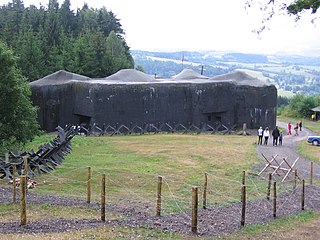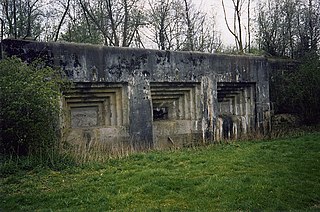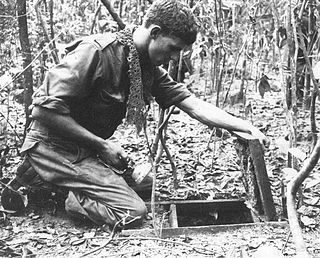 W
WTunnel warfare is a general name for war being conducted in tunnels and other underground cavities. It often includes the construction of underground facilities in order to attack or defend, and the use of existing natural caves and artificial underground facilities for military purposes. Tunnels can be used to undermine fortifications and slip into enemy territory for a surprise attack, while it can strengthen a defence by creating the possibility of ambush, counterattack and the ability to transfer troops from one portion of the battleground to another unseen and protected. Also, tunnels can serve as shelter for combatants and non-combatants from enemy attack.
 W
WThe Andong Tunnel is a tunnel in Dongyin Township, Lienchiang County, Taiwan.
 W
WThe Beihai Tunnel is a tunnel in Banli Village, Beigan Township, Lienchiang County, Taiwan.
 W
WThe Beihai Tunnel is a tunnel in Dongyin Township, Lienchiang County, Taiwan.
 W
WThe Beihai Tunnel is a tunnel in Nangan Township, Lienchiang County, Taiwan. It is located between Ren-ai Village and Meishi Village. The tunnel runs from Tieban Coast deep into the heart of the hills in lattice shape.
 W
WCzechoslovakia built a system of border fortifications as well as some fortified defensive lines inland, from 1935 to 1938 as a defensive countermeasure against the rising threat of Nazi Germany. The objective of the fortifications was to prevent the taking of key areas by an enemy—not only Germany but also Hungary and Poland—by means of a sudden attack before the mobilization of the Czechoslovak Army could be completed, and to enable effective defense until allies—Britain and France, and possibly the Soviet Union—could help.
 W
WFort Eben-Emael is an inactive Belgian fortress located between Liège and Maastricht, on the Belgian-Dutch border, near the Albert Canal. It was designed to defend Belgium from a German attack across the narrow belt of Dutch territory in the region. Constructed in 1931–1935, it was reputed to be impregnable and at the time, the largest in the world. The fort was neutralized by glider-borne German troops on 10 May 1940 during the Second World War. The action cleared the way for German ground forces to enter Belgium, unhindered by fire from Eben-Emael. Still the property of the Belgian Army, the fort has been preserved and may be visited.
 W
WThe Jincheng Civil Defense Tunnel is a tunnel in Jincheng Township, Kinmen County, Taiwan.
 W
WThe Jiugong Tunnel or Siwei Tunnel is a tunnel in Lieyu Township, Kinmen County, Taiwan. It was used during the 1958 Second Taiwan Strait Crisis, when the island was heavily shelled by People's Republic of China. Supplies and equipment from larger ocean going ships were brought in to shore by smaller vessels. They were unloaded in the tunnel safe from the bombardments.
 W
WThe Maginot Line, named after the French Minister of War André Maginot, is a line of concrete fortifications, obstacles, and weapon installations built by France in the 1930s to deter invasion by Germany and force them to move around the fortifications.
 W
WThe Festungsfront Oder-Warthe-Bogen, also called the Festung im Oder-Warthe-Bogen or Ostwall, and in Polish the Międzyrzecki Rejon Umocniony, MRU, was a fortified military defence line of Nazi Germany between the Oder and Warta rivers, near Międzyrzecz. The part around Międzyrzecz (Meseritz) has been colloquially referred to as the Regenwurmlager. Built in 1934–44, it was the most technologically advanced fortification system of Nazi Germany, and remains one of the largest and the most interesting systems of this type in the world today. It consists of around 100 concrete defence structures partially interconnected by a network of tunnels. Some of the forts and tunnels are available for visiting.
 W
WOperation Northern Shield was an Israeli military operation that took place from 4 December 2018 until 13 January 2019. The operation’s declared goal was to locate and destroy Hezbollah tunnels that cross the Blue Line from Lebanon into northern Israel. According to Israel, this operation is part of the ongoing Iran–Israel proxy conflict. On 17 December 2018, United Nations Interim Force in Lebanon (UNIFIL) acknowledged the existence of four tunnels near the Israel–Lebanon border, but said "UNIFIL at this stage can confirm that two of the tunnels cross the Blue Line" in violations of United Nations Security Council Resolution 1701, which helped end the 2006 Lebanon War.
 W
WHamas, the governing authority in the Gaza Strip, has constructed a sophisticated network of military tunnels since it seized control of the Strip in 2007. The tunnel system branches beneath many Gazan towns and cities, such as Khan Yunis, Jabalia and the Shati refugee camp. The internal tunnels, running some dozens of kilometres within the Gaza Strip, have several functions. Hamas uses the tunnels to hide its arsenal of rocketry underground, to facilitate communication, to permit munition stocks to be hidden and to conceal militants, making detection from the air difficult. Hamas leader Khalid Meshal has said in an interview with Vanity Fair that their tunnel system is a defensive structure designed to place obstacles against Israel's powerful military arsenal, to protect its people, and engage in counter-strikes against the IDF when Gaza is attacked, and that it has never caused the death of civilians, being safer than their system of unguidable missiles which are not intended to threaten civilians but strike indiscriminately.
 W
WThe Festungsfront Oder-Warthe-Bogen, also called the Festung im Oder-Warthe-Bogen or Ostwall, and in Polish the Międzyrzecki Rejon Umocniony, MRU, was a fortified military defence line of Nazi Germany between the Oder and Warta rivers, near Międzyrzecz. The part around Międzyrzecz (Meseritz) has been colloquially referred to as the Regenwurmlager. Built in 1934–44, it was the most technologically advanced fortification system of Nazi Germany, and remains one of the largest and the most interesting systems of this type in the world today. It consists of around 100 concrete defence structures partially interconnected by a network of tunnels. Some of the forts and tunnels are available for visiting.
 W
WThe Second Sino-Japanese War was a military conflict that was primarily waged between the Republic of China and the Empire of Japan from 7 July 1937 to 2 September 1945. The start of the war is typically considered to be the Marco Polo Bridge Incident in 1937, in which a dispute between Japanese and Chinese troops escalated into a full-scale invasion. Some sources in the modern People's Republic of China date the beginning of the war to the Japanese invasion of Manchuria in 1931. In China, it is known as the War of Resistance against Japanese Aggression.
 W
WThe Tunnel 88 is a tunnel in Nangan Township, Lienchiang County, Taiwan.
 W
WThe tunnel rats were American, Australian, New Zealander, and South Vietnamese soldiers who performed underground search and destroy missions during the Vietnam War.
 W
WThe Zhaishan Tunnel is a tunnel in Jincheng Township, Kinmen County, Taiwan. Under the agreement of the Ministry of National Defense, the tunnel can be used by the Republic of China Armed Forces during wartime or for military exercise.